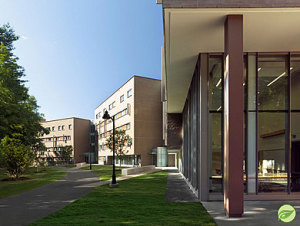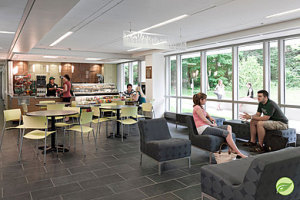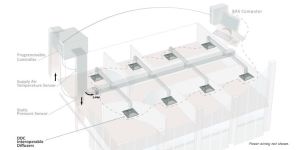| Project Name: | Plymouth State – Langdon Woods Residence Hall |
| Owner: | Plymouth State University |
| Architect: | Cannon Design – Boston |
| Mechanical Engineer: | Rist-Frost-Shumway Engineering |
| General Contractor: | Engelberth Construction, Inc. |
| Equipment: | Thermally Powered VAV Diffusers |
| Manufacturer: | Acutherm |
| DAC Sales Engineer: | Rick McGinley |
Plymouth State University’s LEED® Gold-certified Langdon Woods Residence Hall
 Project scope:
Project scope:
Plymouth State University’s LEED® Gold-certified Langdon Woods Residence Hall is is the first New Hampshire building and one of the first and largest residence halls in the country to receive gold-level certification from the U.S. Green Building Council’s Leadership in Energy and Environmental Design
Sustainable Strategies
Langdon Woods is 58% more energy efficient than a conventional building of this size, saving the university nearly $230,000 a year. A 40% reduction in water use conserves almost 1.4 million gallons of water a year; 20% of all materials in the building are recycled with 40% coming from within 500 miles of the project site, to cut down on transportation emissions; almost 70% of the wood in the building was harvested from responsibly managed forests; low-maintenance plantings require no irrigation; and 70% of construction waste was diverted from landfills.
 The building features operable windows (large windows provide daylighting and views to 90% of living spaces) and individual airflow, with thermally-powered VAV system provided by Acutherm. The Therma-Fuser DDC Interoperable Diffusers meet the set comfort requirement of each space automatically and eliminate over heating and over cooling.
The building features operable windows (large windows provide daylighting and views to 90% of living spaces) and individual airflow, with thermally-powered VAV system provided by Acutherm. The Therma-Fuser DDC Interoperable Diffusers meet the set comfort requirement of each space automatically and eliminate over heating and over cooling.
Therma-Fuser DDC Interoperable Diffusers

Acutherm Interoperable Therma-Fusers
Achieve benefits of Therma-Fuser VAV and complete digital input and output with the BAS. Each diffuser has the ability to supply room temperature, airflow and supply air temperature and receive signals for room temperature setpoint, minimum airflow setpoint, maximum airflow setpoint, override open, override closed, CO2 override and more. Digital signals can be either BACnet™ or LonTalk®. The BAS also monitors and controls the portions of the VAV system requiring periodic maintenance. This approach provides the Therma-Fuser VAV advantages of comfort and energy savings from individual temperature control and easy adaptability to office changes
Related Blog Posts:
Energy Saving VAV Diffusers | 6 Options for Building Automation Systems
Integrate VAV Diffusers Using BACnet






Leave a Reply